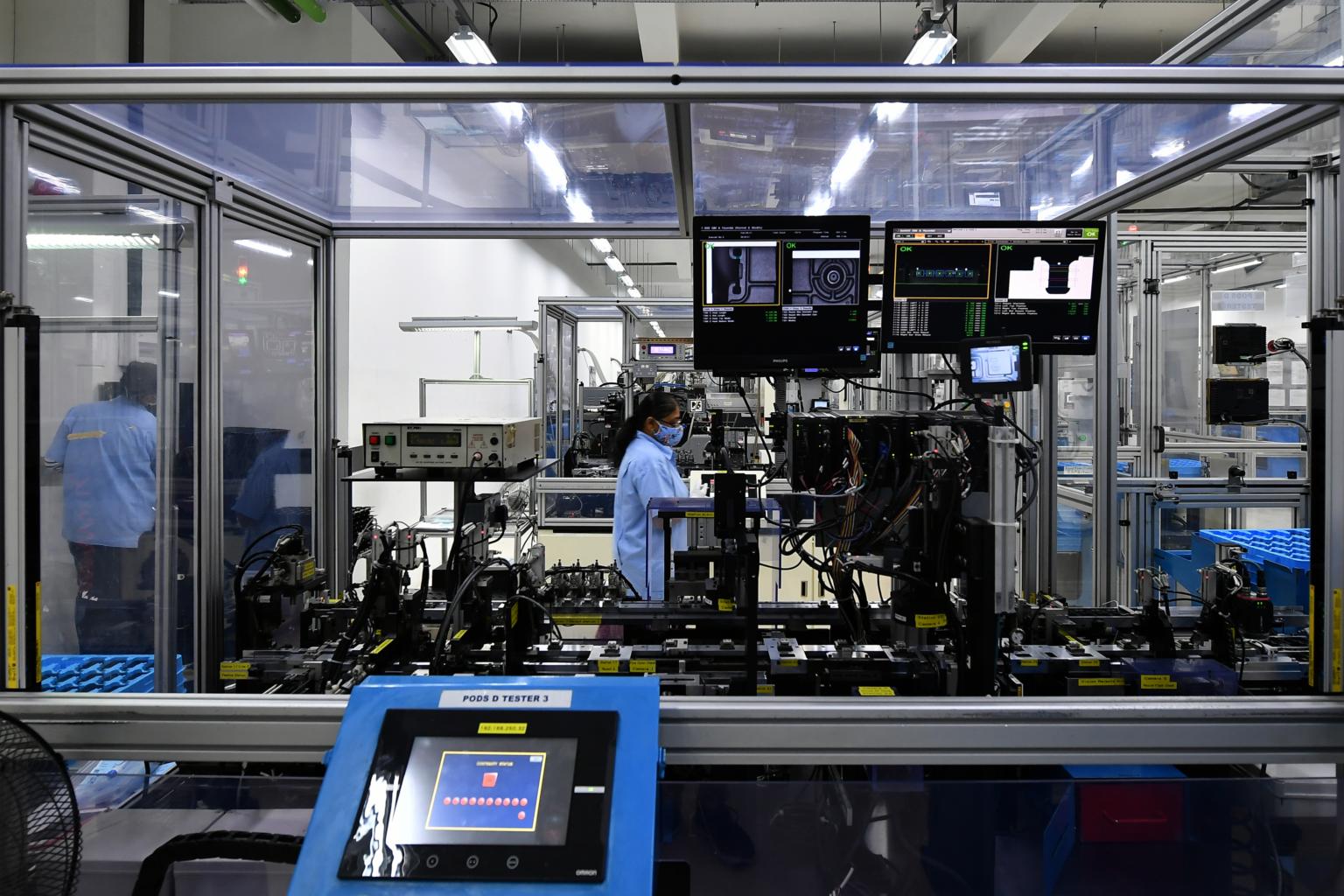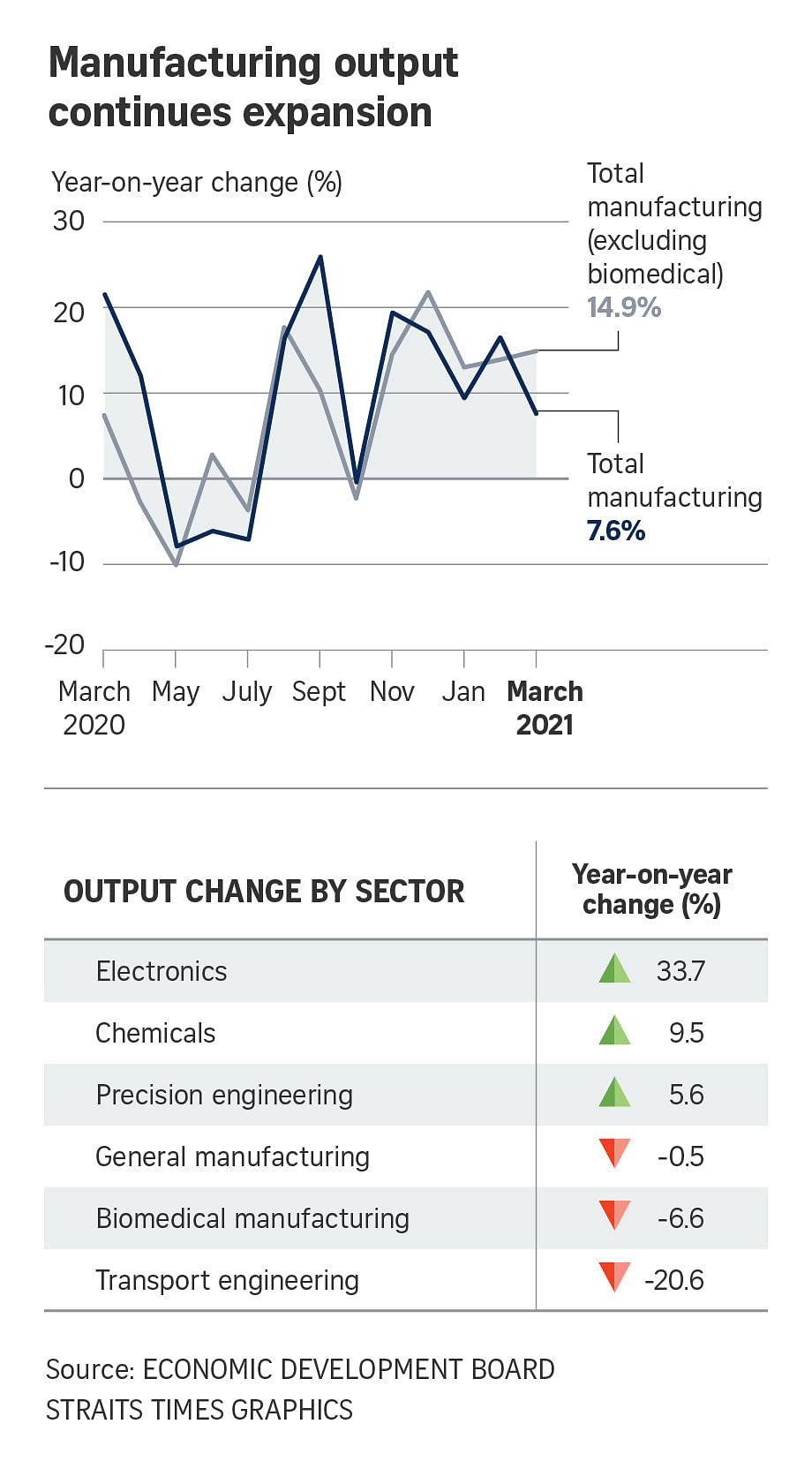Singapore factory output expands 7.6% for fifth consecutive month of growth
Sign up now: Get ST's newsletters delivered to your inbox

Manufacturing production in March increased 7.6 per cent from a year ago.
ST PHOTO: LIM YAOHUI
Jolene Ang
Follow topic:
SINGAPORE - The Republic's factory output expanded for the fifth straight month in March, data released on Monday (April 26) by the Economic Development Board (EDB) show.
Manufacturing production in March increased 7.6 per cent from a year ago, though on a seasonally adjusted month-on-month basis, output decreased 1.7 per cent.
Excluding biomedical manufacturing, March output grew 14.9 per cent year on year but fell 3.2 per cent month on month.
The key electronics cluster saw output swell 33.7 per cent year on year. The semiconductors segment recorded 37.8 per cent growth, supported by demand from cloud services, data centres and 5G markets, EDB said.
The computer peripherals and data storage segments grew 27.4 per cent, while the remaining electronic segments recorded a contraction in output.
The chemicals sector expanded 9.5 per cent last month compared with a year ago.
The petrochemicals segment grew 21.7 per cent from a low base last year because of plant maintenance shutdowns, while the specialities segment expanded 10.9 per cent with higher production of mineral oil additives.
However, the other chemicals and petroleum segments declined 9.9 per cent and 17 per cent respectively.
Output in the precision engineering sector rose 5.6 per cent year on year last month.
The machinery and systems segment grew 8.3 per cent with higher production of semiconductor equipment to cater to the strong capital investment in the global semiconductor industry.
The precision modules and components segment rose 5.7 per cent, on account of higher production of optical instrument and metal precision components.
UOB economist Barnabas Gan said growth can be expected in the electronics and precision engineering clusters due to the gain in global semiconductor-related demand, coupled with the increase in digital solutions adoption, such as 5G technology and cloud computing, around the world.
The chemicals cluster should also see growth on the back of higher global oil prices, he added.
Other clusters saw output shrink in March. General manufacturing contracted 0.5 per cent year on year.
The food, beverage and tobacco segment dipped 5.7 per cent with lower production of milk powder products because of lower export demand. The printing segment was also down, falling 9.6 per cent.
Biomedical manufacturing production fell 6.6 per cent last month, compared with a year ago.
The medical technology segment surged 23.3 per cent with higher export demand for medical devices, but the pharmaceuticals segment declined 9.6 per cent with lower output of biological products.
Transport engineering output fell 20.6 per cent year on year. The marine and offshore engineering segment contracted 20.9 per cent, while the aerospace segment plunged 26.8 per cent.
EDB said the levels of activity in the shipyards and aerospace firms remained low as new orders were still adversely impacted by the weak global oil and gas market, and travel restrictions respectively.
Maybank Kim Eng economists Chua Hak Bin and Lee Ju Ye said the manufacturing sector has been a key growth driver for Singapore, with services and construction recovering more slowly.
They noted that port congestion and component shortages have not dampened the manufacturing and export recovery so far.
But they added: "Manufacturing's momentum will likely ease in the second half as utilisation is reaching full capacity limits, particularly for semiconductors.
"The downside risk is in construction, which may face further delays on building and housing projects following the ban on long-term pass holders and short-term visitors from India starting April 24."


